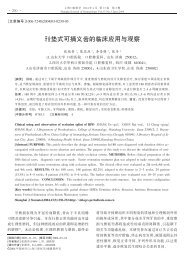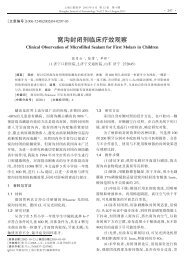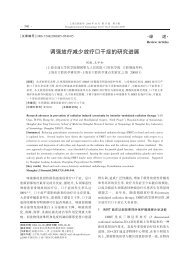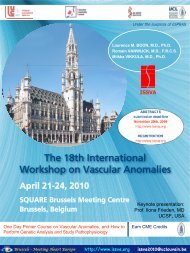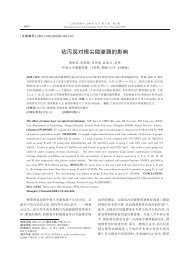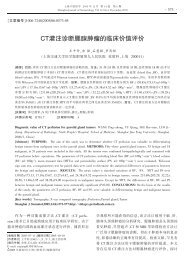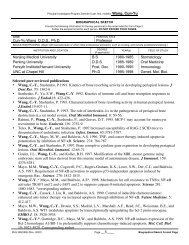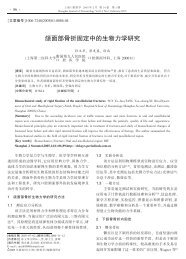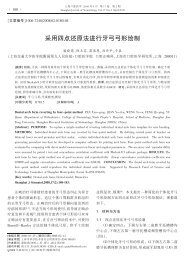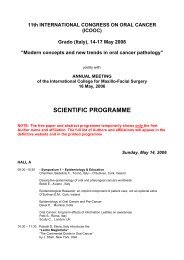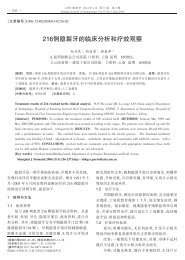core curriculum cleft lip/palate craniofacial anomalies
core curriculum cleft lip/palate craniofacial anomalies
core curriculum cleft lip/palate craniofacial anomalies
You also want an ePaper? Increase the reach of your titles
YUMPU automatically turns print PDFs into web optimized ePapers that Google loves.
Core Curriculum for Cleft Palate and other Craniofacial Anomalies<br />
II.<br />
III.<br />
Classification and Anatomy<br />
The <strong>cleft</strong> or <strong>craniofacial</strong> anomaly is usually classified during the initial examination of the<br />
infant. Craniofacial <strong>anomalies</strong>, other than <strong>cleft</strong>s, are discussed in Section IV.<br />
A. Clefts of the <strong>lip</strong> and <strong>cleft</strong>s of the <strong>palate</strong> can occur simultaneously or separately.<br />
B. The most common classification system for <strong>cleft</strong>ing uses the terms primary and<br />
secondary <strong>palate</strong> to define the <strong>cleft</strong>.<br />
C. The dividing point of the primary and secondary <strong>palate</strong> is the incisive foramen. The<br />
primary <strong>palate</strong> is anterior to this anatomic point and the secondary <strong>palate</strong> is posterior<br />
to it.<br />
D. The primary <strong>palate</strong> includes:<br />
1. Lip<br />
2. Alveolus<br />
E. The secondary <strong>palate</strong> includes:<br />
1. Hard <strong>palate</strong><br />
2. Soft <strong>palate</strong><br />
3. Uvula<br />
F. Any <strong>cleft</strong> of the primary or secondary <strong>palate</strong> may be complete or incomplete,<br />
depending on whether or not the <strong>cleft</strong> involves the entire anatomic structure.<br />
G. Any <strong>cleft</strong> of the primary or secondary <strong>palate</strong> may be unilateral or bilateral.<br />
H. Submucous <strong>cleft</strong>s of the secondary <strong>palate</strong> may also occur. These can be detected by<br />
visual inspection, ultrasonography or radiography.<br />
Airway and Feeding<br />
As with any newborn, the primary concerns in the neonatal period are airway maintenance,<br />
breathing, and feeding. Some of the anatomic variations in children with <strong>cleft</strong>s and<br />
<strong>craniofacial</strong> <strong>anomalies</strong> may have an impact on these functions.<br />
A. Airway maintenance<br />
1. Cleft <strong>lip</strong> and/or <strong>cleft</strong> <strong>palate</strong> rarely cause problems with the upper airway or<br />
breathing, when there are no other associated problems.<br />
2. Pierre-Robin Sequence is the most common anatomic deviation associated<br />
with <strong>cleft</strong>ing that can result in airway and breathing problems.<br />
a. Pierre-Robin Sequence results in a combination of malformations,<br />
consisting of mandibular hypoplasia, glossoptosis, and midline <strong>cleft</strong><br />
of the secondary <strong>palate</strong>.<br />
b. Usually airway problems can be managed with prone positioning and<br />
time for growth to occur. However, dental prosthetic or surgical<br />
intervention, including tracheostomy, may be required in severe<br />
cases. In addition, distraction osteogenesis of the mandible has been<br />
used to treat some infants with severe airway problems due to Pierre<br />
Robin Sequence, but its use at this age is controversial.<br />
3. Craniofacial <strong>anomalies</strong> can also be associated with airway problems. These<br />
include, but are not limited, to:<br />
a. Syndromal craniosynostosis with severe midface hypoplasia.<br />
b. Any syndrome associated with a severely deficient mandible, such as<br />
severe Treacher-Collins Syndrome.<br />
6<br />
© 2004 American Cleft Palate-Craniofacial Association



